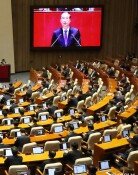Which Way Will Korean Stock Market Go?
Which Way Will Korean Stock Market Go?
Posted August. 13, 2007 07:08,
How far will the effects of the U.S. subprime mortgage loan rate on the world stock market go?
As of August 10 (local time) the U.S. stock market stopped its slip downward thanks to emergency support by the Federal Reserve Board (FRB) and regained stability, but the EU stock market continued to be weakened from the shock.
August 13, the first day of a new week, is expected to become the turning point that will decide the future flow of the Korean stock market, which experienced a nosedive on August 10 caused by concerns over a global financial crisis. There is also possibility that the changes in the Asian stock markets including those of South Korea and Japan on August 13 will have considerable influence on the world financial market.
Meanwhile, the government plans to hold a financial policy meeting on August 13 and discuss the influence the domestic financial market will receive from the insolvency of the subprime mortgage loan rate and corresponding countermeasures.
The U.S. stock market regains stability but the EU market doesnt -
On August 10, the New York stock market index fell at a lower rate than before, unlike the preceding two days when it fell by more than two percent. FRB played a big role by supplying 24 billion dollars of short-term money to the market on the previous day and additional support of 38 billion dollars over three times on August 10.
The Dow Jones Industrial Average and Nasdaq indexes were lower by 0.23 percent and 0.45 percent, respectively, than the day before, and the Standard & Poor`s (S&P) 500 index rose by 0.04 percent.
In contrast, the EU stock price, where money stocks dominate, nosedived for two straight days despite full support by the EU Central Bank.
The South Korean government found out that domestic financial institutions do not have large sums of money directly related to the subpime mortgage loan rate, but is hurrying to prepare countermeasures against possible dangers anyway.
The government decided to strengthen its monitoring system over the domestic financial market while simultaneously coming up with countermeasures for possible scenarios at a financial policy meeting on August 13 which will be attended by the first Vice Minister of Finance and Economy Kim Seok-dong, the Vice Commissioner of the Financial Supervisory Commission Yun Yong-ro, and the Vice President of the Bank of Korea Lee Seung-il.
If any problems occur, such as a credit crunch, the Bank of Korea will increase the supply of liquidity in the form of purchasing repurchase bonds (RP), said a Ministry of Finance and Economy official. We will also examine the facts relevant to foreign asset management operations by domestic financial companies.
A Financial Supervisory Commission official explained, The meeting on August 13 is largely intended to give the market the message that the government is keeping an eye on the concerns over the insolvency of the U.S. subprime mortgage rate.
Large fluctuations likely to occur in the Korean financial market-
The views of the financial sector point to a high possibility that the influence from the current crisis will last for a while because risk factors have not been removed despite the emergency measures by central banks of each country.
A straight upward line like the one shown during the second quarter (April~June) is unlikely to reappear in the Korean stock market because a strong correction has started, said researcher Kim Hak-gyun of Korea Investment Co. Since risk factors continue to exist, there is a high possibility that the stock price will fluctuate.
But some also give the opinion that there will not be a large drop because individuals and institutions will support the stock price with strong purchases, though foreigners will continue to sell off. Net purchases by individuals on August 10 amounted to 741.1 billion won, the highest ever.
Some also point to the possibility of a weakening of the won (a rise in the won-dollar exchange rate) and a drop in the interest rate of bonds.







